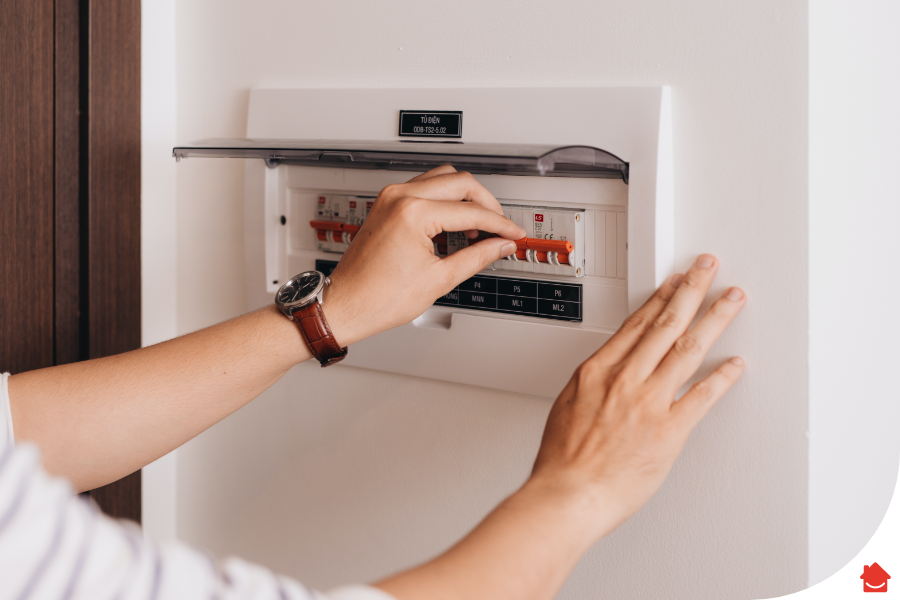Ohhhhh! The fuse box tripped again. Right in the middle of the game? It can be frustrating if your fuse box keeps tripping and you don’t know why. It’s a sign that somewhere in your home you might be harbouring a faulty electrical appliance or wiring.
You could just reset it every time it trips…or you could do your best Columbo impression to find the culprit causing the problem, and fix it—once and for all! This guide will help you work out why your fuse box tripped and how to help stop it happening again.
Where is my fuse box?
Your fuse box (or consumer unit, as electricians call it) can usually be found on the ground floor if you live in a house, underneath the stairs. Try to keep the area around your consumer unit clear so you can easily access the switches in an emergency. If you live in a flat, the unit is usually higher up on a wall in your hallway.
How does a fuse box or consumer unit work?
A fuse box is absolutely vital to the safety of your household (sort of like the gatekeeper between you and all the electrical currents coming into your home from the mains electricity supply).
These currents could be fatally dangerous if a fault or surge occurs, so the fuse box works by detecting any unusual activity and then cutting off the flow of electricity through that circuit if it gets too high. Electrical fires, electric shocks and other accidents would happen all too frequently if modern homes weren’t fitted with fuse boxes or circuit breakers.
Do I have circuit breakers or fuses?
When you open your fuse box panel, you’ll be able to see if you have fuses or circuit breakers. Circuit breakers look like a row of levers or switches. Fuses are less modern – they’re round and screw into sockets like little light bulbs.
If your circuit breakers or fuses aren’t clearly labelled, do yourself a favour and mark them up according to what room and which lights and sockets go off when you switch them on. Your future self will thank you if a circuit ever breaks.
Whichever kind of fuse box you’ve got, you’ll have a main on/off switch, which you can use to shut off all electricity flowing into your house from the mains supply.
How do I know if my fuse box has tripped?
If a certain room or area in your house has lost power or lighting, one of your circuit breakers has probably tripped. You’ll see that the switch is in a different on/off position from all the rest.
How do I reset a tripped fuse box?
Turn off the circuit breaker by moving the switch back to the on position like the rest of the breakers. It’s a good idea to keep a torch next to your unit for those times when the lighting’s gone on in that area or if there’s a full blackout.
How does a fuse box work?
To understand how a fuse box works, it’s important to understand how your home is wired. Electrical wiring includes three wires:
- Live
A live wire carries the electric current.
- Neutral
A neutral wire carries the current back to the original power source.
- Earth
The earth wire sends the signal to your circuit breaker to switch off the electric current to the circuit that has the fault. It also provides a path of least resistance for the current to flow to the ground.
If you open up an appliance’s plug to change it, say a kettle, you’ll see the live, neutral and earth wires. In a safe set-up, the live and neutral wires are prevented from touching each other, and the electrical current will pass through your kettle to power it, then back to the circuit that particular socket is on.
Your kettle has a high level of ‘resistance’, which keeps the voltage at a safe level for it to be able to do its job – boil water. Every appliance has a level of resistance that regulates the voltage and keeps it safe to use.
Common reasons for your circuit breaker to trip
If your circuit breaker has tripped, it’ll be down to one of three types of faults:
- Short circuit
- Ground fault
- Circuit overload
What are the differences between a short circuit, a ground fault and a circuit overload?
Learn the three types of electrical faults and you’ll be able to get back to whatever you were doing in no time.
Short circuit
If a fault causes the live and neutral wires somewhere in the circuit to come into contact, a large amount of current will flow and overload the circuit. Short circuits are dangerous because high levels of electricity can heat up the wiring and cause a fire.
However, your circuit breaker will detect the surge and then trip, or a fuse will blow. You may also see sparks and smoke, or hear popping sounds. The circuit breaker has now cut power to the circuit until the issue can be resolved.
A short circuit can be caused by a faulty electrical switch, outlet, appliance, plug or cord. You could try to trace the short circuit yourself to one of these culprits.
Check if one of your electric cords is shorting out
Sometimes you get a cord shorting out if you’ve moved it recently, or maybe there’s visible damage from a pet chewing on it. In this case, you’ll need to stop using it immediately and replace the cord.
If you think you have a short circuit and you can’t easily see what’s caused it, call a qualified electrician for help, or have electrical cover in place so we can do this for you.
Ground fault
A ground fault occurs when the live wire makes contact with something that’s earthed – either the earth wire or an earthed or grounded part of the junction box or a grounded area of an appliance. Live wires are usually brown, neutral wires are usually blue, and ground wires are usually striped green and yellow.
When a live wire makes contact with an earth wire or earthed area, a surge of electrical current goes to the circuit breaker which trips. Ground faults usually happen when equipment is faulty.
Ground faults can cause a nasty electric shock that can be fatal, especially if the person’s body gives the electrical current the path of least resistance to the earth.
Kitchens and bathrooms are especially dangerous for this reason. So, if you suspect you may have a ground fault, get it fixed immediately to prevent any accidents.
Circuit overload
An overloaded circuit usually occurs because too many appliances are plugged into the same circuit. For example, if you’re making a brew, toasting some waffles, charging your iPhone, you’ve just put in a load of laundry in and switched on the tumble dryer, and you’re playing on your Xbox at the same time, you might be overloading your electricity. This will particularly be the case if a lot of these appliances are plugged into the same sockets.
Overloading your sockets is actually extremely dangerous – the circuit simply doesn’t have the kind of extra amperage all these appliances need. If you do find you need more plug sockets for a certain area of your home, it’s worth finding out how to change a plug socket so it’s more suited to your needs.
Extension leads can cause overloaded circuits
Extension leads often cause an overloaded circuit. Even though they provide multiple sockets, it doesn’t mean you should use all of them at once – this will be heavily taxing on the particular circuit that serves the wall socket your lead is plugged into. Try to distribute your appliances more evenly and test again.
How to identify what caused your circuit to overload
To fix this problem, you’ll need to determine which room it was in and which appliance caused it.
- After dutifully following our above instructions to correctly label which circuit breakers or fuses in your consumer unit relate to which rooms in your home, you’ll quickly be able to see which one has tripped and therefore narrow in on the relevant room.
- Before you reset your fuse box or circuit breaker, go to that room and unplug all the items on the circuit.
- Now go back to the consumer unit, reset the breaker or fuse and wait a few minutes.
- After a few minutes, take one of the items and plug it in, turn it on and test if the circuit breaks again.
- Systematically turn on or plug in each item in the circuit, one at a time, to test which is causing the overload.
- Once you’ve identified the culprit, try plugging it in somewhere else and you will probably solve the problem. If not, it sounds like your appliance is faulty.
What should I do with the faulty appliance?
Once you identify a faulty appliance, don’t use it again until you’ve had it checked over. If it’s new and still under warranty, take it back to the shop you bought it from and get a refund or replacement.
Older devices are unlikely to be under warranty, so if it’s not a chewed cord or damaged plug, which you can investigate yourself, you’ll need to get it looked at by a qualified electrician.
How to prevent circuit overloads
To prevent circuit overloads in future, put your large appliances on their own, dedicated circuits. If circuit overloads keep happening in your home on a regular basis; in your kitchen, for example, you may need to install a new circuit and socket to handle the amperage load.
Is my immersion heater tripping my fuse box?
This is a common one. If your main circuit breaker switch keeps tripping in the night and you can see that it’s the immersion heater trip switch that is off, it’s more than likely that the immersion heater element has gone and needs replacing.
How can I tell if my fuse box or circuit breaker is faulty?
All appliances in your home can wear out or develop a fault and circuit breakers are no different. Warning signs of a faulty circuit breaker include:
- The main breaker is tripping, but the individual breakers are fine
- The breaker won’t stay reset
- A burning smell in the electrical box
- A circuit breaker that keeps tripping frequently
- Signs of damage to a breaker, like scorch marks
If your consumer unit is old (if you still have a fuse box then it’s really old!) or your electrical panel hasn’t been serviced in the last five years, you need to get on it or consider having it repaired or replaced. Call a professional electrician at this point – don’t start fiddling about with the fuse box’s interior if you’re not professionally trained.
What to do if your fuse box trip switch still won’t reset
Fixing a fuse box is no job for the casual home DIYer.
If you do all the checks and your fuse box or circuit breaker is still tripping with nothing plugged in—plus it still won’t reset—it’s time to call a professional electrician. You can easily call our expert repair team as a one-off, or you could futureproof and protect your home from ever struggling with something like this again.
If you’re a homeowner or landlord, and want peace of mind that issues like this can be quickly identified and sorted, our electrical cover is exactly what you’re looking for. Once in place, if there’s a problem, you can relax knowing we’ll be on our way to fix it in no time.
Learn more about electrical cover.
FAQs
Still got questions? Our home experts are here to help with the answers you need.
Why does my fuse box keep tripping out?
Your fuse box or circuit breaker works by detecting any surges or unusual activity and then cutting off the flow of electricity through that circuit if it gets too high.
How do you fix a breaker that keeps tripping?
If you‘ve followed all the checks in this article to identify the room and then the socket or appliance or behaviour that’s causing the circuit breaker to keep tripping, you may have a faulty breaker. For example, you might be overloading the circuit by plugging too many appliances into one circuit.
The simplest way to fix a breaker that keeps tripping? Call a professional.
How to find what is tripping my circuit breaker
Before you reset the breaker, unplug any appliances. Now reset, and test each appliance by plugging them in, one by one, to see which appliance is tripping the breaker. Don’t use the appliance again until it’s either fixed or replaced.




